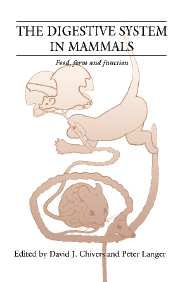Book contents
- Frontmatter
- Contents
- List of contributors
- Preface
- Part I Introduction
- Part II Food
- Part III Form
- 12 The form of selected regions of the gastro-intestinal tract
- 13 Categorisation of food items relevant to oral processing
- 14 A direct method for measurement of gross surface area of mammalian gastro-intestinal tracts
- 15 Morphometric methods for determining surface enlargement at the microscopic level in the large intestine and their application
- 16 Weaning time and bypass structures in the forestomachs of Marsupialia and Eutheria
- 17 Adaptations in the large intestine allowing small animals to eat fibrous foods
- Part IV Function
- Part V Synthesis and perspectives
- Index
16 - Weaning time and bypass structures in the forestomachs of Marsupialia and Eutheria
Published online by Cambridge University Press: 18 March 2010
- Frontmatter
- Contents
- List of contributors
- Preface
- Part I Introduction
- Part II Food
- Part III Form
- 12 The form of selected regions of the gastro-intestinal tract
- 13 Categorisation of food items relevant to oral processing
- 14 A direct method for measurement of gross surface area of mammalian gastro-intestinal tracts
- 15 Morphometric methods for determining surface enlargement at the microscopic level in the large intestine and their application
- 16 Weaning time and bypass structures in the forestomachs of Marsupialia and Eutheria
- 17 Adaptations in the large intestine allowing small animals to eat fibrous foods
- Part IV Function
- Part V Synthesis and perspectives
- Index
Summary
At weaning, the herbivorous mammal undergoes a digestive metamorphosis which, although not as obvious to the casual observer, is as significant as the transformation of a tadpole to a frog.
P. A. Janssens and J. H. Ternouth (1987)Introduction
How do animals digest their food? Considering this question, it is possible to differentiate two groups, namely, those species that are able to digest the ingesta with their own enzymes (autoenzymatic digestion) and, secondly, species eating a food that can only be digested with the help of microbial fermentation (alloenzymatic digestion). The latter type is necessary when plant material is eaten, as plants contain structural carbohydrates in their cell walls: mainly cellulose with pi-4 linkages between D-glucose monomers. The cell-wall carbohydrates can be encrusted to different extents with lignin and can thus be made highly resistant to microbial degradation. Bacteria and, in many cases, protozoans and sometimes even fungi, are the organisms that have to colonize the gastro-intestinal tract of mammals with alloenzymatic digestion (Savage, 1972, 1983; Church, 1988). Both the large intestine and, in some cases, the forestomach are regions of the tract that have been widened to ‘fermentation vats’. Although the main products of microbial activity, namely short-chained fatty acids, can be absorbed in the forestomach and in the large intestine (Stevens, 1988), the efficiency of digestion in both regions of the tract is quite different (Demeyer and de Graeve, 1991). Protein and amino acids are microbially synthesized in the forestomach of ruminants and are digested in the hindstomach and small intestine with subsequent absorption of their end-products (Stevens, 1988).
- Type
- Chapter
- Information
- The Digestive System in MammalsFood Form and Function, pp. 264 - 286Publisher: Cambridge University PressPrint publication year: 1994
- 1
- Cited by



